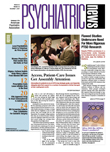The brain is not an immovable object, and when it encounters an irresistible force, the damage may lead to any number of psychiatric consequences.
Call it concussion, closed head injury, or traumatic brain injury (TBI), but a shock to the skull caused by a fall, a motorcycle accident, an overzealous football tackle, or a car bomb in Iraq leaves almost 2 million Americans with problems walking, talking, and thinking every year.
Most insidiously, TBI can cause behavioral problems that can make recovery even more difficult for patients and for those around them, Jeffrey Nicholl, M.D., an associate professor of clinical neurology and psychiatry at Tulane University School of Medicine, told listeners at APA's 2007 Institute on Psychiatric Services in New Orleans.
“TBI takes a huge toll on families,” said Nicholl, especially when the injury itself leaves the patient unaware of changes in personality, judgment, and behavior. “The person they've known all those years is gone.”
These patients may show a range of neurological and psychiatric symptoms, from delirium or depression to anxiety or even psychosis, he said. While symptoms at first may mimic those seen in common psychiatric practice, often treatments have to be modified in light of the patient's neurological injuries.
The frontal and temporal lobe poles are most vulnerable to head injury, especially given the rough surfaces of the skull below them, said Nicholl. Damage occurs not only with the first wave of the blast or blow but when the brain bounces back and strikes the skull on the side from which the force came. Initial effects include bruising, bleeding, and diffuse axonal injury, caused by shearing forces and axial rotation.
Shearing injury occurs when axons are overstretched as the cerebrum turns while the brainstem remains in position, explained Nicholl. During axial rotation, the head turns to one side. When that happens suddenly, the brainstem turns, but the cerebrum does not follow instantly.
White matter in the parasagittal areas, the corpus callosum, the internal capsule, and the upper brainstem are likely sites of damage. Secondary effects in the brain can include hypoxia, ischemia, edema, intracranial pressure, and infections.
Neuropsychological testing can help determine the extent of the damage, as can several imaging techniques. MRI can show structural lesions, fMRI can locate deficits in task-specific operations, and MR spectroscopy can pinpoint neuronal loss.
Delirium and amnesia may appear as the patient returns to consciousness, said Nicholl. To alleviate their effects, he recommended careful use of atypical neuroleptics.
“Typicals can slow cognitive recovery,” he said. “TBI patients are more sensitive to CNS-active agents, both in terms of efficacy and side effects, so start with very low doses.”
Cognitive deficits may show up as reduced attention, poor executive function, or slowed thinking; fMRI scans show wider brain activation during memory tasks in TBI patients, indicating that additional parts of the brain must be recruited to accomplish the same task.
“There are almost no double-blind, controlled studies on treating cognitive dysfunction in TBI patients,” said Nicholl. Stimulants or tricyclic antidepressants may help. Mood modulators like lamotrigine may increase alertness, and dopaminergics or dopamine agonists may improve cognitive abilities—although the reason is unknown, he said. Others have tried Alzheimer's treatments such as cholinesterase inhibitors, but Nicholl was “underwhelmed” by their effects.
Patients may appear apathetic, with reduced emotional responses and abilities to plan or act, he said. Anatomically, apathy reflects damage to the orbitofrontal and medial frontal cortex, the ventral palladium, and the ventral tegmentum.
Clinicians should carefully differentiate apathy from depression.
“Apathetic TBI patients may appear depressed, but they are not dysphoric,” he said. “They're just kind of blah.”
Apathy can be worsened by SSRIs and typical antidepressants, but patients may respond to activating antidepressants like bupropion or MAOIs, or to stimulants or L-dopa and dopamine agonists, he said. “Family interventions or setting up the environment to reward goal-directed activity can help too.”
TBI experts measure severity of TBI using the Glasgow Coma Score (scoring ranges from 3 to 15, with lower numbers indicating greater severity) to rate verbal and motor abilities and eye response to stimulation. “Mild” TBI, the most commonly occurring, rates a score of 13 to 15 and loss of consciousness lasting less than 30 minutes. MRI can show white matter abnormalities and their return to normal as patients improve. SPECT and PET imaging may reveal damage that MRI may not, especially in the frontal and temporal lobes or in the thalamus, home to memory and emotional circuits.
Patients with mild TBI may test in the normal range on neuropsychological examinations but still show slowed mental processing and impaired memory. Fifty percent of patients are depressed, 20 percent meet criteria for major depressive disorder, and 25 percent have anxiety. Perhaps 1.5 percent may briefly have psychosis, which does not come from seizures, he said.“ They don't have the flatness of affect and appear emotionally engaged.”
PTSD is actually less common in patients with TBI compared with other badly injured patients without head trauma, he said. “To have PTSD, you have to remember what happened to you.”
Mild TBI patients have trouble functioning and may be unable to return to work. About 80 percent are disabled at three months and 25 percent at one year following injury.
Older patients and those, like athletes, with previous TBIs or a history of substance abuse (especially alcohol) are likely to have a worse prognosis.
Injury to the frontal lobe and the limbic system can cause increased disinhibition, producing a reactive, explosive, unpremeditated aggressive behavior unseen before their injury in between 40 percent and 70 percent of patients. Behavioral therapy that controls punishment and reward can often help these patients. Antiseizure medication (especially carbamazepine), some antidepressants, or stimulants (amantadine or methylphenidate) may also be useful. Beta blockers—especially those like propanolol that can pass the blood-brain barrier—used at high doses (12mg/kg/day) have proven useful, possibly by blocking the neurotransmitter effects of norepinephrine in the brain. They should be built up slowly while monitoring blood pressure and pulse, he said.
Personality disorder, which can appear one, five, or even 15 years after the original event, is the “most disabling psychiatric sequela of TBI,” said Nicholl. It is caused by both diffuse axonal injury and more focal, especially frontal, injury. Patients become more impulsive and aggressive and lack empathy and an ability to self-monitor. Tricyclics and SSRIs may help with lability, but the “childlike behavior” of patients suggests that psychotherapy based on Erickson's stages of development would be useful, he said.
Most critically for the care of TBI patients is their lack of insight into their condition, said Nicholl. Half of all patients with moderate to severe TBI are unaware of their deficits or lack emotional reactions to them, setting up roadblocks to successful rehabilitation.
“How do you get someone to work on a problem they do not believe they have or do not care about?” he said.
For further reading, Nicholl suggested The Man With a Shattered World by A.R. Luria, foreword by Oliver Sacks (Harvard University Press, 2004). ▪

